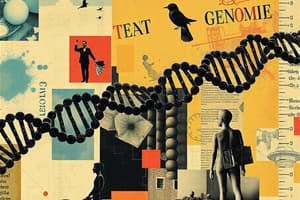Podcast
Questions and Answers
What is the primary advantage of Next-Generation Sequencing (NGS) over Sanger Sequencing?
What is the primary advantage of Next-Generation Sequencing (NGS) over Sanger Sequencing?
- Ability to generate millions of short reads (correct)
- Use of more expensive reagents
- Longer read lengths than Sanger
- Higher accuracy for long reads
Which platform is known for its long-read sequencing capability?
Which platform is known for its long-read sequencing capability?
- Illumina Sequencing
- Pacific Biosciences (PacBio) (correct)
- Ion Torrent
- Sanger Sequencing
Which sequencing technology is primarily based on detecting pH changes?
Which sequencing technology is primarily based on detecting pH changes?
- Ion Torrent (correct)
- Sanger Sequencing
- SOLiD Sequencing
- Illumina Sequencing
What is a key characteristic of Sanger Sequencing?
What is a key characteristic of Sanger Sequencing?
Which of the following applications is NOT typically associated with genome sequencing?
Which of the following applications is NOT typically associated with genome sequencing?
What is the read length of Illumina Sequencing typically?
What is the read length of Illumina Sequencing typically?
What is a major challenge faced by sequencing technologies?
What is a major challenge faced by sequencing technologies?
Which sequencing method is characterized by using sequencing by oligonucleotide ligation and detection?
Which sequencing method is characterized by using sequencing by oligonucleotide ligation and detection?
Study Notes
Sequencing Technologies
-
Overview of Genome Sequencing
- Process of determining the complete DNA sequence of an organism's genome.
- Critical for genomics, personalized medicine, evolutionary biology, and more.
-
Main Sequencing Technologies
-
Sanger Sequencing
- First-generation sequencing method.
- Uses chain-terminating inhibitors.
- High accuracy (99.99%) for short reads (up to 1000 bp).
- Limited throughput; typically used for smaller-scale projects.
-
Next-Generation Sequencing (NGS)
- High-throughput technologies allowing massive parallel sequencing.
- Key platforms:
- Illumina Sequencing
- Uses reversible dye terminators.
- Generates millions of short reads (75-300 bp).
- Cost-effective for large-scale projects.
- Ion Torrent
- Based on semiconductor technology.
- Measures pH change for nucleotide incorporation.
- Relatively fast and cheaper, but with shorter read lengths.
- SOLiD Sequencing
- Uses sequencing by oligonucleotide ligation and detection.
- Generates shorter reads with high accuracy.
- Lesser-used compared to Illumina or Ion Torrent.
- Illumina Sequencing
-
Third-Generation Sequencing
- Provides long-read sequencing capabilities.
- Key platforms:
- Pacific Biosciences (PacBio)
- Uses single-molecule real-time (SMRT) sequencing.
- Long reads (up to 15,000 bp or more) with lower accuracy.
- Suitable for complex genomes and structural variants.
- Oxford Nanopore
- Portable sequencing technology.
- Reads can exceed 1 million bp.
- Real-time data analysis and direct RNA sequencing capabilities.
- Pacific Biosciences (PacBio)
-
-
Comparative Aspects
- Read Length
- Sanger: ~1000 bp.
- Illumina: 75-300 bp.
- PacBio and Oxford Nanopore: up to millions of bp.
- Throughput
- NGS technologies greatly surpass Sanger in throughput.
- Cost
- NGS methods are more cost-effective for large datasets compared to Sanger.
- Read Length
-
Applications
- Clinical Diagnostics
- Targeted sequencing for genetic disorders.
- Metagenomics
- Analysis of microbial communities.
- Cancer Genomics
- Identification of mutations and personalized treatment options.
- Population Genomics
- Study of genetic variation across populations.
- Clinical Diagnostics
-
Challenges
- Data management and storage due to large output.
- Bioinformatics tools required for assembly and analysis.
- Overcoming biases and errors in different sequencing technologies.
Overview of Genome Sequencing
- Genome sequencing determines the complete DNA sequence of an organism's genome.
- Essential for fields such as genomics, personalized medicine, and evolutionary biology.
Main Sequencing Technologies
-
Sanger Sequencing
- First-generation method using chain-terminating inhibitors.
- Achieves a high accuracy of 99.99% for shorter reads (up to 1000 bp).
- Limited throughput, often used in smaller-scale projects.
-
Next-Generation Sequencing (NGS)
- Offers high-throughput technologies for massive parallel sequencing.
- Key platforms include:
- Illumina Sequencing
- Utilizes reversible dye terminators.
- Produces millions of short reads (75-300 bp).
- Cost-effective for large-scale genomic projects.
- Ion Torrent
- Based on semiconductor technology measuring pH change during nucleotide incorporation.
- Known for its relative speed and lower costs but provides shorter read lengths.
- SOLiD Sequencing
- Employs oligonucleotide ligation and detection for sequencing.
- Generates short reads with high accuracy but is less commonly used than Illumina or Ion Torrent.
- Illumina Sequencing
-
Third-Generation Sequencing
- Focuses on long-read sequencing capabilities.
- Key platforms include:
- Pacific Biosciences (PacBio)
- Uses single-molecule real-time (SMRT) sequencing.
- Long reads (up to 15,000 bp or more) but with lower accuracy.
- Suitable for complex genomes and structural variant analysis.
- Oxford Nanopore
- Portable technology capable of ultra-long reads (exceeding 1 million bp).
- Features real-time data analysis and the ability to conduct direct RNA sequencing.
- Pacific Biosciences (PacBio)
Comparative Aspects
-
Read Lengths
- Sanger: approximately 1000 bp.
- Illumina: generates 75-300 bp reads.
- PacBio and Oxford Nanopore: can produce reads up to millions of bp.
-
Throughput and Cost
- NGS technologies offer significantly higher throughput than Sanger sequencing.
- NGS methods are generally more cost-effective for handling large datasets.
Applications
-
Clinical Diagnostics
- Targeted sequencing to identify genetic disorders.
-
Metagenomics
- Analyzes microbial communities in various environments.
-
Cancer Genomics
- Identifies mutations for personalized treatment options.
-
Population Genomics
- Investigates genetic variation and diversity across different populations.
Challenges
- Managing and storing large data outputs from sequencing.
- Requires advanced bioinformatics tools for data assembly and analysis.
- Need to address biases and errors inherent in various sequencing technologies.
Studying That Suits You
Use AI to generate personalized quizzes and flashcards to suit your learning preferences.
Description
Explore the various genome sequencing technologies including Sanger Sequencing and Next-Generation Sequencing (NGS). Understand their methods, accuracy, and applications in genomics and personalized medicine. This quiz covers key platforms like Illumina and Ion Torrent and their significance in modern biology.



